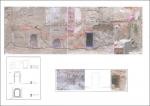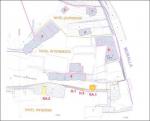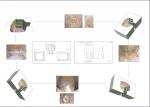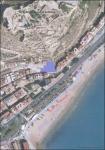Summary (English)
The construction work on the new public school San Roque, next to the castle of Santa Barbara, necessitated a prior, mandatory archaeological excavation. During that excavation, a find was documented and, due to its uniqueness, age, and state of preservation, it was decided that it should remain in situ.
The excavation of this has uncovered a rock face on the slopes of Benacantil on which, in ancient times, alcoves and a rock-cut chamber were made. The niches have different forms and are intended to relate to the chamber. The chamber is quadrangular and has, carved into the rock, elements which clearly link it to a cultural use: long benches, notches to support a wooden altar, holes to support decorative elements and columbaria niches or arches, some with a Latin cross painted on their interior. Since no archaeological levels have been found inside the chamber, it is only possible to date this rock-cut structure using parallels and similar archaeological contexts.
The characteristics of this structure seem to indicate that it is a kind of oratory or small chapel of a religious nature. The Latin-style crosses link it to Christian practice. Inside, there are seven niches (difficult to specify due to the lack of associated finds) located on two of its sides; on the third, there is a long bench on which a small community could sit. At the front can be found a small wooden altar on which the objects of the liturgy or prayer would be placed.
This type of structure has been dated, on the Iberian Peninsula as well as in the rest of the Mediterranean, in a wide time frame between the 5th-6th centuries AD and the 10th century, or namely, from Late Antiquity until the start of the Islamic era. This chronology could be accepted in this case considering that a late Roman settlement at the summit of Mount Benacantil has now been documented, which had its peak between the aforementioned 5th and 6th centuries AD. This settlement endured over time, as evidenced by the findings of ceramics from the Byzantine and the Visigoth era. For these two historical periods, two nearby necropolis have been located and excavated, in the current Municipal Archive and in the Ereta Park, respectively. This last burial ground is very close to where the described rupestrian structures have appeared. Other finds from the Visigoth era confirm the importance of Christianity in the area. In addition, there is even evidence to suggest the possibility of a Mozarabic context. For all of these reasons, it is very difficult to specify to which of these historical periods we could assign the excavated remains, and as such, we must continue with the commonly accepted chronology of the 5th-6th centuries to the 10th century AD.
(translation by Alex Redmond)
- Margarita Borrego Colomer, Pablo Rosser Limiña y Ana Valero Climent
Director
- Margarita Borrego Colomer (Patronato Municipal de la Vivienda), Pablo Rosser Limiñana (COPHIAM) y Pedro J. Abarca Hernández (arqueólogo)
Team
- Ana Valero Climent (ESTRATS, Treballs d’Arqueologia)
Research Body
- Diputación Provincial de Alicante, Museo Arqueológico de Alicante (MARQ)
Funding Body
- Excmo. Ayuntamiento de Alicante






![Download [PDF]](/excavation/skins/fasti/images/results/download_sml.png)


